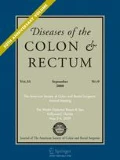Abstract
The structure of the anal canal was examined in histology slides. Hemorrhoids are normal features of the human anatomy. They are pads that bulge into the lumen. Hemorrhoids have three parts: 1) the lining, which can be mucosa or anoderm; 2) the stroma with blood vessels, smooth muscle, and supporting connective tissue; and 3) the anchoring connective tissue system, which secures the hemorrhoids to the internal sphincter and the conjoined longitudinal coat. The anchoring and supporting connective tissue system deteriorates with aging. The hemorrhoids not only bulge, but descend into the lumen. This becomes observable in the third decade of life, with individual differences. The veins become distended as they lose their support. The descended loose lining becomes more sensitive to pressure from straining and to trauma from the stool. There can be a stasis in the veins, with clot formations and swelling or erosions of the lining, with bleeding. The hemorrhoids become symptomatic.
Similar content being viewed by others
References
Stelzner F. Die Hämorrhoiden und andere Krankheiten des Corpus cavernosum recti und des Analkanals. Dtsch Med Wchnschr 1963;88:689–96.
Thomson WH. The nature of haemorrhoids. Br J Surg 1975; 62:542–52.
Burkitt DP. Hemorrhoids, varicose veins and deep vein thrombosis: epidemiologic features and suggestive causative factors. Can J Surg 1975;18:483–8.
Brondel H, Gondran M. Facteurs pre disposants lies a l'hérédité et a la profession dans la maladie hémorroï daire. Arch Fr Mal App Dig 1976;65:541–50.
Haas PA, Fox TA Jr. The importance of the perianal connective tissue in the surgical anatomy and function of the anus. Dis Colon Rectum 1977;20:303–13.
Haas PA, Fox TA Jr. Age-related changes and scar formations of the perianal connective tissue. Dis Colon Rectum 1979;23:160–9.
Haas PA, Haas GP, Schmaltz S, Fox TA. The prevalence of hemorrhoids. Dis Colon Rectum 1983;26:435–39.
Ackerman LV, Butcher HR. Surgical pathology. 3rd ed. St. Louis: CV Mosby, 1969.
Anderson WA. Pathology 5th ed. St. Louis: CV Mosby, 1966.
Graham-Stewart CW. What causes hemorrhoids? A new theory of etiology. Dis Colon Rectum 1963;6:333–44.
Burkitt DP, Graham-Stewart CW. Haemorrhoids—postulated pathogenesis and proposed prevention. Postgrad Med J 1975; 51:631–6.
Jacobs DM, Bubrick MP, Onstad GR, Hitchcock CR. The relationship of hemorrhoids to portal hypertension. Dis Colon Rectum 1980;23:567–9.
Hirschowitz B. Medical Grand Rounds, University of Alabama Center. South Med J 1969;62:266–74.
Swart B. Überlegungen zur Genese typischer Kollateralkreisläufe bei portalem Hochdruck und deren röntgenologisch-klinische Symptomatologie. Radiologe 1968;8:73–83.
Miles WE. Observations upon internal piles. Surg Gynecol Obstet 1919;29:497–506.
Thulesius O, Gjöres JE. Arterio-venous anastomoses in the anal region with reference to the pathogenesis and treatment of hemorrhoids. Acta Chir Scand 1973;139:476–8.
Wilson PM. Anorectal closing mechanisms. S Afr Med J 1977; 51:802–8.
Gass OC, Adams J. Hemorrhoids: etiology and pathology. Am J Surg 1950;29:40–3.
Jackson CC, Robertson E. Etiologic aspects of hemorrhoidal disease. Dis Colon Rectum 1965;8:185–9.
Tagart REB. Haemorrhoids and palpable ano-rectal lesions. Practitioner 1974;212:221–38.
Strehler BL. Time, cells and aging. New York: Academic Press, 1963:138–45.
Bornstein P. Disorders of connective tissue function and the aging process: a synthesis and review of current concepts and findings. Mech Agein Dev 1976;5:305–14.
Fine J, Lawes CHW. On the muscle fibers of the anal submucosa with special reference to the pecten band. Br J Surg 1940;27:723–7.
Collopy BT. Internal haemorrhoids: observations on their nature and classification in relation to their management. Aust NZ J Surg 1980;50:167–9.
Nesselrod JP. Hemorrhoids (letter to Editor). Arch Surg 1974; 109:458.
McGivney J. A reevaluation of etiologic factors of hemorrhoidal disease. Ariz Med 1967;24:333–6.
Hansen HH. Neue Aspekte zur Pathogenese und Therapie des Hämorrhoidalleidens. Dtsch Med Wchnschr 1977;102:1244–8.
Lord PH. Approach to the treatment of anorectal disease with a special reference to hemorrhoids. Surg Annu 1977;9:195–9.
Eisenhammer S. Internal anal sphincterotomy plus free dilatation versus anal stretch with special criticism of the anal stretch procedure for hemorrhoids: the recommended modern approach to hemorrhoid treatment. Dis Colon Rectum 1974;17:493–522.
Author information
Authors and Affiliations
Additional information
Read at the meeting of the American Society of Colon and Rectal Surgeons, San Francisco, California, May 2 to 6, 1982.
About this article
Cite this article
Haas, P.A., Fox, T.A. & Haas, G.P. The pathogenesis of Hemorrhoids. Dis Colon Rectum 27, 442–450 (1984). https://doi.org/10.1007/BF02555533
Issue Date:
DOI: https://doi.org/10.1007/BF02555533




